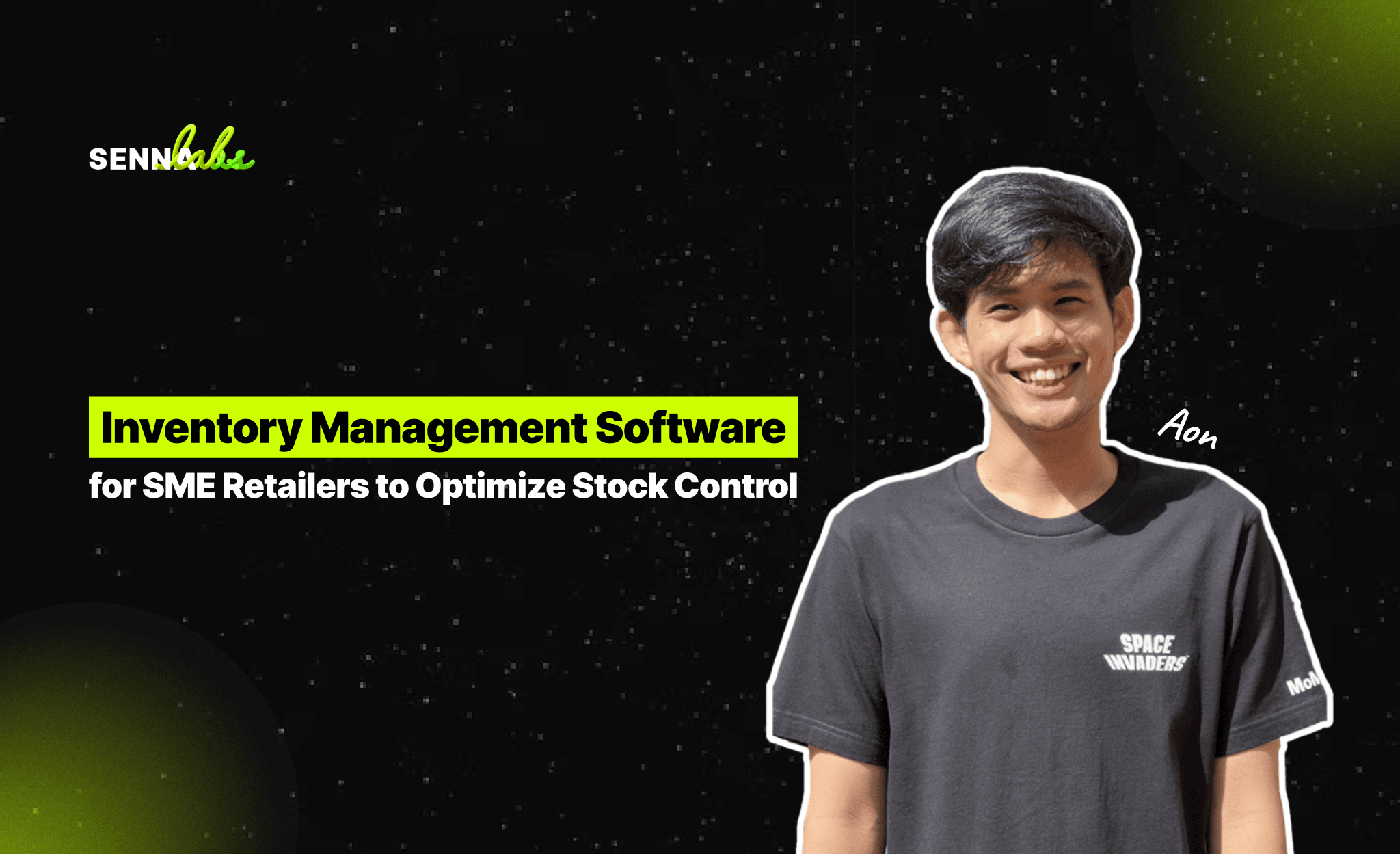Inventory Management Software for SME Retailers to Optimize Stock Control

For small and medium-sized retailers, inventory management is a critical factor that determines business success. Poor stock control can lead to lost sales due to stock shortages or financial losses from overstocking slow-moving items. Manual inventory tracking using spreadsheets or handwritten logs often leads to errors, inefficiencies, and difficulty in forecasting demand.
An inventory management system helps SME retailers track stock levels in real-time, receive low-stock alerts, and optimize restocking decisions. Using AI-powered forecasting, retailers—especially in fashion and boutique stores—can analyze sales trends, prevent stock imbalances, and improve cash flow.
This article explores the importance of inventory management software for SME retailers, essential features to look for, and how a clothing boutique improved operations through real-time inventory tracking.

Why SME Retailers Need Inventory Management Software
Many SME retailers struggle with poor inventory control, leading to loss of revenue and inefficiencies. An automated inventory management system ensures businesses can streamline stock tracking, improve purchasing decisions, and enhance overall efficiency.
Key Benefits of an Inventory Management System for SME Retailers
1. Real-Time Inventory Tracking
-
Provides instant stock updates when a sale is made.
-
Prevents overselling and avoids running out of popular items.
2. Low-Stock Alerts and Auto-Restocking
-
Sends automatic alerts when stock levels drop below a certain threshold.
-
Integrates with suppliers for automatic reordering.
3. AI-Powered Sales Forecasting
-
Uses sales history and trends to predict demand.
-
Helps business owners restock fast-moving items and avoid excess inventory costs.
4. Multi-Store and Multi-Channel Syncing
-
Syncs inventory across physical stores, e-commerce platforms, and warehouses.
-
Provides a unified view of stock availability across different sales channels.
5. Reduces Losses from Overstocking and Waste
-
Identifies slow-moving stock to prevent over-purchasing.
-
Enables seasonal and promotional planning for clearing old stock.
Essential Features of an Inventory Management System for SME Retailers
1. Real-Time Stock Updates
-
Tracks inventory movements instantly across stores and warehouses.
-
Updates stock availability when sales occur, reducing discrepancies.
2. Barcode and RFID Integration
-
Scans items for faster check-in and check-out.
-
Minimizes human error and speeds up inventory audits.
3. Low-Stock and Overstock Alerts
-
Notifies when stock levels are running low or exceeding limits.
-
Prevents stockouts of best-selling products.
4. AI-Driven Demand Forecasting
-
Uses data analytics to predict future sales trends.
-
Helps in planning seasonal inventory and promotional offers.
5. Multi-Store and E-Commerce Integration
-
Syncs with online stores such as Shopify, WooCommerce, and Amazon.
-
Allows seamless tracking of inventory across different locations.
6. Automated Purchase Orders
-
Automatically reorders stock when levels are low.
-
Helps retailers negotiate better pricing with suppliers.
Use Case: Real-Time Inventory Tracking for a Clothing Boutique
Challenges Faced by the Clothing Boutique Before Implementing Inventory Software
-
Inaccurate Stock Tracking
-
The boutique manually updated inventory, leading to frequent discrepancies between recorded and actual stock.
-
Some popular items went out of stock too soon, causing lost sales opportunities.
-
Overstocking and Unnecessary Expenses
-
The owner over-purchased certain items, leading to unsold stock and financial losses.
-
Clearance sales had to be held frequently to move excess inventory.
-
Difficulty Managing Online and In-Store Inventory
-
The boutique sold through both an online store and a physical location, but inventory updates were not synchronized.
-
Online customers purchased out-of-stock items, leading to order cancellations and negative customer reviews.
-
No Sales Insights or Demand Forecasting
-
The boutique had no historical sales data analysis.
-
Purchasing decisions were based on assumptions rather than real data.
How the Inventory Management Software Solved These Issues
-
Automated and Real-Time Inventory Updates
-
The system automatically updated stock when an item was sold in-store or online.
-
Eliminated manual data entry and inventory mismatches.
-
AI-Powered Demand Forecasting
-
The boutique could analyze which items sold best during different seasons.
-
The system suggested restocking schedules based on historical sales trends.
-
Multi-Channel Integration
-
The software synchronized stock levels between the online store and physical shop.
-
Prevented overselling of unavailable products.
-
Optimized Restocking and Cost Control
-
The owner received automated alerts for low-stock items.
-
Overstocked items were identified early and discounted accordingly, preventing financial loss.
Results After Implementing the Inventory Management Software
-
30% reduction in stock discrepancies, improving operational efficiency.
-
40% increase in sales, as popular items were consistently in stock.
-
20% reduction in overstocking costs, leading to higher profit margins.
-
Improved customer satisfaction, as online and in-store stock levels matched accurately.
How to Choose the Right Inventory Management Software for Your SME
If you’re considering inventory management software for your retail business, here are the key factors to evaluate:
1. Business Size and Complexity
-
Small retailers may need a basic stock tracking system, while larger businesses require multi-location inventory control.
2. Integration with Existing Systems
-
Ensure the software integrates with POS, e-commerce, and accounting software.
3. Cloud-Based and Mobile Compatibility
-
Choose a system with remote access so you can track inventory anytime, anywhere.
4. Scalability and Automation
-
A good inventory system should grow with your business and offer AI-driven automation.
5. Cost and Customer Support
-
Compare pricing plans and ensure the software provider offers reliable customer support.
Common Mistakes to Avoid When Choosing Inventory Software
-
Not Choosing a Scalable Solution – Ensure the software can handle business growth.
-
Ignoring Automation Features – Manual inventory tracking increases errors and inefficiencies.
-
Not Integrating with Sales Channels – A system without POS and e-commerce syncing can cause stock issues.
-
Overlooking Reporting and Forecasting Tools – Data analytics help businesses optimize purchasing decisions.
Conclusion
For SME retailers, an inventory management system is an essential tool for preventing stock shortages, reducing overstocking, and improving sales forecasting. By implementing real-time tracking, AI-powered analytics, and multi-channel synchronization, businesses can enhance efficiency, minimize losses, and improve profitability.
The case study of a clothing boutique demonstrated how automated inventory management reduced errors, improved stock control, and increased revenue. Retailers looking to streamline inventory operations and enhance customer satisfaction should invest in a customized inventory management solution that fits their specific business needs.
Choosing the right inventory management software will not only save time and money but also help retailers grow sustainably in a competitive market.


Subscribe to follow product news, latest in technology, solutions, and updates
Other articles for you



Let’s build digital products that are simply awesome !
We will get back to you within 24 hours!Go to contact us Please tell us your ideas.
Please tell us your ideas.







